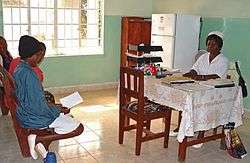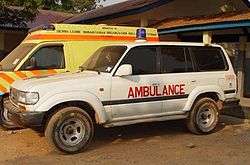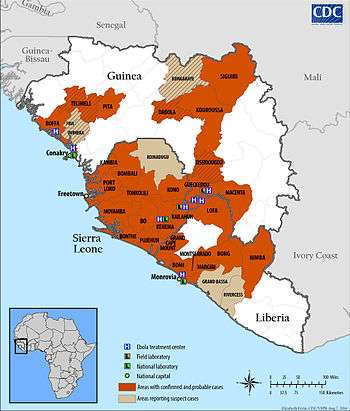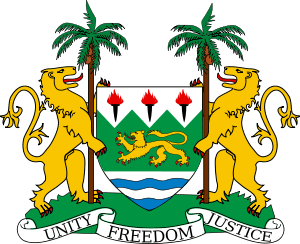Health in Sierra Leone

In terms of available healthcare and health status Sierra Leone is rated very poorly. Globally, infant and maternal mortality rates remain among the highest.[1] The major causes of illness within the country are preventable with modern technology and medical advances. Most deaths within the country are attributed to nutritional deficiencies, lack of access to clean water, pneumonia, diarrhoeal diseases, anaemia, malaria, tuberculosis and HIV/AIDS.
Health infrastructure

All medical care is generally charged for in Sierra Leone[2] and is provided by a mixture of government, private and non-governmental organizations (NGOs). There are over 100 NGOs operating in the health care sector in Sierra Leone. The Ministry of Health and Sanitation is responsible for organising health care and after the end of the civil war the ministry changed to a decentralised structure of health provision to try to increase its coverage.[3]
Sierra Leone is divided into 13 health districts that correspond to the districts of Sierra Leone except for the Western Area Rural and Western Area Urban districts which are combined into the Western Area Health district. Each district has a health management team and an average of 50 peripheral health units (PHU) and over 100 technical staff. The management team is responsible for planning, organising and monitoring health provision, training personnel, working with communities and supplying equipment and drugs.[3]
The PHUs are designed to be the delivery point for primary health care in the country and there are three main types.
- The community health centre carries out health prevention measures, cures and health promotion activities and is in charge of overseeing the other PHUs in the area. It is planned that each chiefdom, the unit of local government in Sierra Leone below the level of district, should have at least one community health centre.[3]
- Community health posts perform a similar function to community health centres but have fewer facilities and are used to refer patients to the health centre or the district hospital.[3]
- Maternal and Child Health posts are the first level of contact on the ground and are located in smaller towns of with populations between 500-2000. Much of the health care infrastructure was decimated during the Civil War and the health service is still in the process of being organised with hospitals and PHU being rebuilt or created and staff being trained.[3]
Free healthcare scheme
In April 2010 Sierra Leone launched "Free Health Care Medical Insurance", a system of free healthcare for pregnant and breast-feeding women and children under five.[4][5] A UN population Fund representative said that medical equipment had been ordered and some drugs distributed as part of the new healthcare scheme but the coverage was not yet 100%.[5] The initial set up cost of the scheme was $19 million and it is expected to save the lives of more than a million mothers and children.[5]
Healthcare workers had gone on strike over the plans in March 2010 arguing that free healthcare would increase their workload and working hours, the government settled the dispute with pay rises of 200-500%.[5] Observers argue that many of the women concerned do not even know they have a right for free medical care and that the law would remain a paper tiger if more earnings from the extractive sector was not invested in the countries healthcare system.[6]
The scheme is funded mainly by the United Kingdom and United Nations who have paid to refurbish hospitals, supply drugs and pay healthcare professionals' wages.[5] The UK alone has agreed to pay for a years worth of drugs for the program and the World Health Organization has provided blood banks in each major town.[7] The British government's funding came from the Department for International Development (DFID) and amounted to $22.6 million to fund the scheme for the next three years from a total allocation of $70.5 million for the 10-year-long "Reproduction and Child Health Care" plan.[8] UNICEF also received $7 million from DFID to provide medicines for pregnant women.[8]
Traditional medicine
Traditional medicine forms part of the primary health care system in Sierra Leone. The traditional medicine programme, run by the Ministry of Health and Sanitation, has constructed a training school at Makeni, a healing centre at Kono and conducted workshops to promote co-operation between traditional medicine practitioners and orthodox medical workers. Members of the programme have also located and collected plants from throughout Sierra Leone used for medicine.[9]
Water supply and sanitation
A 2006 national survey found that 84% of the urban population and 32% of the rural population had access to an improved water source. Those with access in rural areas were served almost exclusively by protected wells. The 68% of the rural population without access to an improved water source relied on surface water (50%), unprotected wells (9%) and unprotected springs (9%).[10][11]
20% of the urban population and 1% of the rural population had access to piped drinking water in their home.[10][11]
Access to an improved water source does not give an indication about whether water supply is continuous.[10][11] For example, in Freetown taps were running dry for most of the year in 2009. People collected water in containers wherever they can and those who can afford it install water tanks on their houses. Even the fire brigade used its trucks to sell drinking water. There were fights between firefighters and employees of the Guma Water Company, responsible for water supply in Freetown, sometimes resulting in deaths.[12]
Hospitals
- Connaught Hospital
- Ola During Children's Hospital
- Princess Christian Maternity Hospital
- Masanga Hospital
- St John of God Hospital
Health status
Life expectancy
The 2014 CIA estimated average life expectancy in Sierra Leone was 57.39 years.[13] in 2015, after improvements in health in other poorer countries life expectancy for both men and women was the lowest in the world.[14]
Endemic diseases
Yellow fever and malaria are endemic to Sierra Leone.[3]
Infectious diseases
Sierra Leone suffers from epidemic outbreaks of diseases including cholera, lassa fever and meningitis.[3]
HIV/AIDS
Sierra Leone has a prevalence of HIV/AIDS in the population of 1.6 percent.[15]
Ebola

In 2014 there was an outbreak of the Ebola virus in Sierra Leone. As of 4 August 2014, there had been 691 cases of Ebola in Sierra Leone, and 286 deaths.[16]
Mental health
Mental healthcare in Sierra Leone is almost non-existent. Many sufferers try to cure themselves with the help of traditional healers.[17] During the Civil War (1991–2002), many soldiers took part in atrocities and many children were forced to fight. This left them traumatised, with an estimated 400,000 people (by 2009) being mentally ill. Thousands of former child soldiers have fallen into substance abuse as they try to blunt their memories.[18] There is one primitive psychiatric facility in Sierra Leone.[19]
Disability
It is estimated that there are about 450,000 disabled people in Sierra Leone,[20] though number could be an under-estimate.[20] Common disabilities in Sierra Leone include blindness, deafness, war wounded, amputees and post-polio syndrome.[20]
Maternal and child healthcare
Maternal mortality statistics in Sierra Leone are among the world's highest. One in eight women risks dying during pregnancy or childbirth.[21]
The 2010 maternal mortality rate per 100,000 births for Sierra Leone is 970. This is compared with 1032.7 in 2008 and 1044.2 in 1990. The under 5 mortality rate, per 1,000 births is 198 and the neonatal mortality as a percentage of under 5's mortality is 25. In Sierra Leone the number of midwives per 1,000 live births is 1 and the lifetime risk of death for pregnant women 1 in 21.[22]
Health conditions and human rights in Sierra Leone
HIV/AIDS
Discrimination based on HIV status is illegal, but HIV-positive people are highly stigmatized, with HIV-positive children being denied schooling, adults denied jobs, and abandonment by families common. Persons with HIV are often driven to suicide.[19]
References
- ↑ "Sierra Leone country profile - BBC News". Bbc.com. 2016-01-21. Retrieved 2016-10-30.
- ↑ "Sierra Leone". The Kambia Appeal. Retrieved 2008-01-24.
- 1 2 3 4 5 6 7 "The Primary Health Care Hand Book Policing" (doc). Ministry of Health & Sanitation. 2007-05-25. Retrieved 2008-01-24.
- ↑ "April 27, 2010 Sierra Leone's Independence and Semi-Health Care Reform Day". Sierra Express Media. 24 April 2010. Archived from the original on October 4, 2011. Retrieved 27 April 2010.
- 1 2 3 4 5 "Sierra Leone starts free care for mothers and children". BBC News. 27 April 2010. Retrieved 27 April 2010.
- ↑ Anne Jung (December 2012). "Wealth, but no health". D+C Development and Cooperation/ dandc.eu.
- ↑ "Sierra Leone gives new hope to mothers and children". BBC News. 27 April 2010. Retrieved 27 April 2010.
- 1 2 Johnson, Kimberley S. (27 April 2010). "Sierra Leone boosts infant health care". Global Post. Retrieved 27 April 2010.
- ↑ "Mission, Objective, Achievements and Aims of the Traditional Medicine Programme". Ministry of Health & Sanitation. 2006-08-11. Retrieved 2008-01-24.
- 1 2 3 "Estimates for the use of Improved Drinking-Water Sources" (PDF). Sierra Leone: WHO / UNICEF Joint Monitoring Programme for Water Supply and Sanitation. March 2010. Archived from the original (PDF) on 26 December 2011.
- 1 2 3 Nataliya Pushak; Vivien Foster (June 2011). "Sierra Leone's Infrastructure. A Continental Perspective" (PDF). Policy Research Working Paper 571. World Bank. pp. 31–35. Retrieved 6 August 2011.
- ↑ Roland Marke:Water Crisis Threatens Survival in Freetown, Op-Ed in Worldpress.org, June 14, 2009
- ↑ "CIA - The World Factbook Life Expectancy". Cia.gov. Retrieved 2014-06-25.
- ↑ "UN: Life expectancy worldwide has increased by 5 years". Calgary Herald. 18 May 2016. Retrieved 19 May 2016.
- ↑ "2006 Report on the global AIDS epidemic" (PDF). UNAIDS. 2006. Retrieved 2008-01-24.
- ↑ "Ebola virus disease, West Africa – update 6 August 2014". Retrieved 29 September 2014.
- ↑ "Unreported World 2009 series, ep.4: Sierra Leone: Insanity of War". Channel4.com. 3 April 2009. Retrieved 20 May 2012.
- ↑ Lisk, Radcliffe (2007). "Sierra Leone". Practical Neurology. 7 (3): 198–201. doi:10.1136/jnnp.2007.120089. PMID 17515600.
- 1 2 "2010 Human Rights Report: Sierra Leone". US State Department. Retrieved January 12, 2013.
- 1 2 3 Government discussion turns to issues of the disabled in Sierra Leone. Jhr.ca. Retrieved on 2011-03-13.
- ↑ Moszynski, P. (22 September 2009). "Sierra Leone's maternal mortality rate is a "human rights emergency"". BMJ. 339 (sep22 2): b3908–b3908. doi:10.1136/bmj.b3908.
- ↑ "The State Of The World's Midwifery". United Nations Population Fund. Retrieved August 2011. Check date values in:
|access-date=(help)
